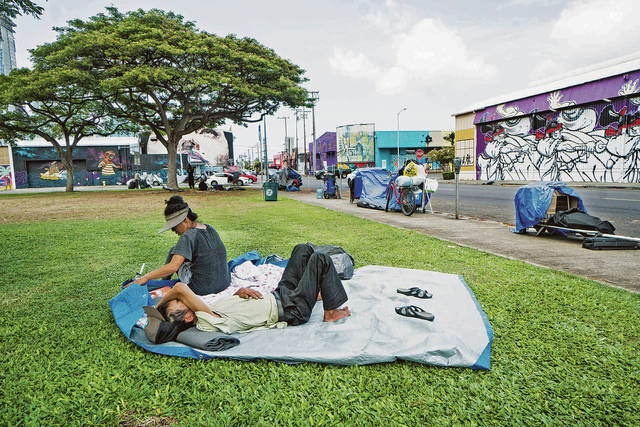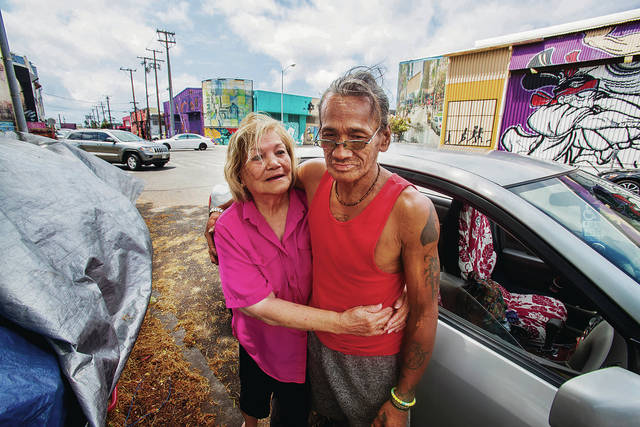Caldwell considers mental health facility as chronic homeless return to park

DENNIS ODA / DODA@STARADVERTISER.COM
Above, a couple rests on a mat in Mother Waldron Park.

DENNIS ODA / DODA@STARADVERTISER.COM
Jean Mantanona hugged her stepson, John Mantanona Jr., who is presently living at the corner of Cooke and Pohukaina streets.


About a dozen chronically homeless people moved back into Kakaako’s Mother Waldron Neighborhood Park on Thursday, prompting Mayor Kirk Caldwell to consider a possible new approach that would divert them into some sort of facility where they would get assessed for substance abuse and mental health issues until they can get housed — rather than face the already congested criminal justice system.
At the same time, in an interview with the Honolulu Star-Advertiser, Caldwell said he hopes to attract organizations such as sports groups to schedule tournaments or practices at Mother Waldron Park to make it more “active” and less attractive to the homeless.
Caldwell called the possibility of some sort of “rudimentary” intake facility for chronically homeless people “a very rough idea we’re thinking about. … We’ll try anything to see if it makes a difference.”
His thoughts on Mother Waldron Park on Thursday follow months of ongoing complaints about Kakaako’s chronically homeless population, which had swelled to more than 300 people around Kakaako Waterfront Park in the summer of 2015 and represented one of the worst homeless encampments in the nation.
While there have been ongoing successes in Kakaako, including 17 people from around Mother Waldron Park who agreed to move into shelters in late May, groups of homeless people continue to generate complaints on nearby city streets, such as busy South Street.
“We’re looking to see what else we can do,” Caldwell said.
Don't miss out on what's happening!
Stay in touch with breaking news, as it happens, conveniently in your email inbox. It's FREE!
The people who showed up at Mother Waldron on Thursday said they had been forced out of nearby Keawe Street by a sweep Wednesday. The city just reopened Mother Waldron on July 6 following a six-week closure for “maintenance.”
It was the second time since December that the park was closed for six weeks of maintenance, which had the effect of also denying park users access to grassy areas, a restroom and basketball courts.
Just before the city shut down Mother Waldron for the second time, police tracked down a 20-year-old Windward resident at his home and arrested him on suspicion of second- and third-degree assault after he allegedly beat a visiting Japanese couple in the park’s bathroom May 28.
Honolulu Deputy Police Chief John McCarthy at the time told the Star-Advertiser that homeless people who were living in Mother Waldron Park intervened in the attack and “made very good witnesses.”
The attack prompted the consulate general of Japan in Honolulu to warn Japanese tourists to be safe while taking pictures of Kakaako’s famous murals — and led to front-page headlines in Japan.
While some homeless people from Kakaako have moved into shelters, others such as Darren Nohara, 53, scattered.
“I was all over” Kakaako, Nohara said.
Many, such as his friend John Mantanona, 59, ended up on the Ewa side of the park on Keawe Street after the park was shuttered.
But homeless activity on Keawe Street attracted complaints “from all the people in high-rises giving us stink-eye,” Mantanona said.
So following Wednesday’s sweep of Keawe Street, Mantanona, Nohara and others were back at Mother Waldron.
Mantanona said he appreciated the efforts to get others into shelters. But he’s not interested.
“I don’t trust nobody for nothing,” Mantanona said. “I value my freedom.”
Following years of homeless sweeps, Mantanona said police, social workers and others tell him, “‘Aren’t you getting tired yet?’ I say, ‘Aren’t you guys tired yet?’”
Moments later Mantanona’s family — including his sister-in-law and mother and father — stopped by Mother Waldron to check on him.
Mantanona’s parents live in Pensacola, Fla., “and I’ve been asking him to come live with me,” said Mantanona’s namesake, retired Vietnam veteran John Mantanona Sr., 79.
The senior Mantanona grew up on Guam, spent 20 years in the Navy — from 1956 to the end of the Vietnam War in 1975 — and mustered out as a petty officer first class. But he can’t convince his son to give up a life of homelessness.
As the younger Mantanona shook his head in the background, Mantanona Sr. pleaded with the Star-Advertiser, “Please, do something to help my son.”
The Vanherreweghe family of Ghent, Belgium — father Steven, mother Carole and their children Louise, 21, and Arnaud, 20 — had just walked by, taking photos of Kakaako’s murals.
During their travels across the country, which included the main Hawaiian Islands, the Vanherreweghes have seen larger homeless populations from New York to Los Angeles and especially in San Francisco.
They even walked past chronically homeless people in Hilo who seemed to be suffering from substance abuse problems.
“Every big city has homeless,” Carole Vanherreweghe said as she stood at the corner of Pohukaina and Cooke streets on the edge of Mother Waldron Park, “and this is a big city.”





